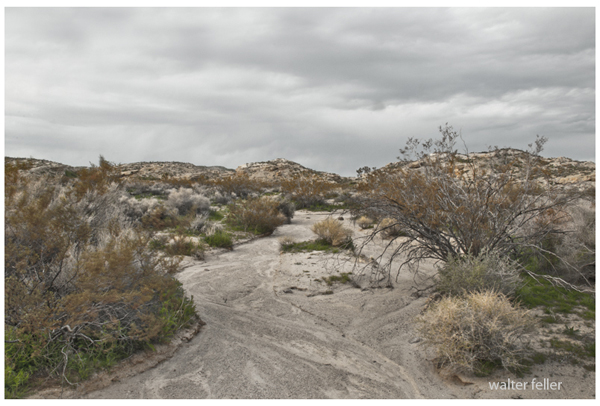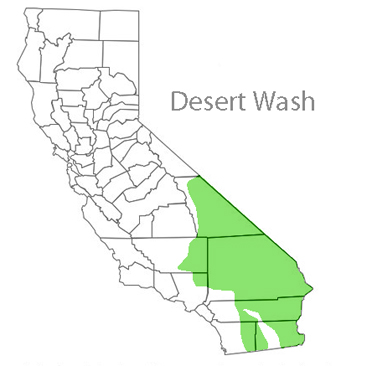Shrub Dominated Wildlife Habitats
Desert Wash
(DSW) Paloverde Species, Desert Ironwood, Mesquite
Vegetation
Structure-- Desert Wash habitats are characterized by the presence of arborescent, often spiny, shrubs generally associated with intermittent streams (washes) or drier bajadas (alluvial deposits adjacent to washes), especially in the Sonoran Desert. Plants comprising Desert Wash habitats generally are taller and denser than those of surrounding desert habitats. Heights of desert wash plants usually do not exceed 5 m (16 ft) (Burk 1977) however, some mesquite stands are as tall as 9 m (30 ft) (Martin 1980). The height of wash vegetation usually is proportional to the size of the arroyo (Shreve and Wiggins 1964). Washes in northern deserts not bounded by arborescent shrubs should be considered taller examples of the surrounding habitat (e.g., Sagebrush). Desert Wash habitats in the south exhibit a more diverse vertical structure than do those in the north.
Composition-- The composition of desert wash plant assemblages depends on variables such as latitude, elevation, and precipitation. Generally, washes in the south are more diverse in plant species composition and vertical structure than washes to the north. Canopy species typically found in washes include blue palo verde, littleleaf paloverde, desert ironwood, smoketree, catclaw acacia, mesquite, screwbean mesquite, and tamarisk (Cheatham and Haller 1975, Burk 1977, Martin 1980, Paysen et al. 1980, Parker and Matyas 1981). Plants of the subcanopy include desert broom, crucillo, Anderson's wolfberry, arrowweed, desert willow (Cheatham and Haller 1975, Burk 1977, Martin 1980, Paysen et al. 1980, Parker and Matyas 1981), as well as small individuals belonging to the dominant canopy species. Ground cover plants include white brittlebush, Opuntia (Martin 1980, Parker and Matyas 1981), snakeweed, goldenbush, saltbush, bursage (Martin 1980), desert lavender (Paysen et al. 1980) as well as a variety of forbs and grasses.
Other Classifications-- Other names for Desert Wash habitats include Palo Verde Series, Catclaw Series, Desert Ironwood Series, Mesquite Series (Paysen et al. 1980, Parker and Matyas 1981), Smoke Tree/Desert Willow Series, (Parker and Matyas 1981), Smoke Tree Series, Desert Willow Series, Salt-cedar Series (Paysen et al. 1980), Mesquite (242) (Martin 1980), and Desert Dry Wash Woodland - 6.32/7.42 (Cheatham and Haller 1975).
Habitat Stages
Vegetation Changes--1,2=4:S-D. Desert Wash habitats may exist in a number of habitat stages ranging from seedling tree/ shrub to large tree; this habitat may be found as any of structural classes 1;2-4;S-D. Canopy development and density is variable and may depend on water supply. Open stands support a variety of understory plants; whereas, in dense stands, ground cover may be limited.
Duration of Stages-- The time required for Desert Wash habitats to progress through successional stages is not known, but probably depends on water availability (e.g., precipitation, ground water). Stand development ultimately depends on water supply and other site characteristics. In very dry areas, stands may persist as underdeveloped stages (e.g., medium tree/shrub stage) rather than progressing to the large tree stage.
Biological Setting
Habitat-- Desert Wash habitats may be adjacent to a variety of desert habitats including Desert Riparian (DRI), Desert Succulent Shrub (DSS), Desert Scrub (DSC), Joshua Tree (JST), Alkali Scrub (ASC), and Palm Oasis (POS).
Wildlife Considerations-- Desert Wash habitats, such as paloverde and desert ironwood associations, are important to wildlife populations. Such habitats support more bird species at higher densities than other desert habitats with the exception of riparian (England et al. 1981)(No England et al. 1981 in Habitat Lit Cite. I used England et al. 1984 as Lit Cite at end.). The dense shrubbery also provide food and cover for other wildlife forms.
Physical Setting
Soils of Desert Wash habitats tend to be sandy (Parker and Matyas 1981) to gravelly (Cheatham and Haller 1975); some wash plants (e.g., mesquite) may be found on a variety of soils. This habitat is often found in association with canyons, arroyos, washes, and other features that contain water for at least part of the year. Furthermore, Desert Wash plants may be found on higher elevation bajadas (Burk 1977). Presence of water during part of the year appears essential for the habitat to persist. In the Sonoran Desert, precipitation declines towards the west and Desert Wash habitats are restricted to areas of greater water availability (Burk 1977). Hot, dry summers and cool to cold moist winters characterize Desert Wash habitats. Highest July temperatures range from 40 to 47 C (104 to 117 F) and lowest January temperatures range from 2 to 6 C (28.4 to 42.8 F) (Rowlands et al., 1982, P. G. Rowlands pers comm.). Most precipitation is in winter but summer rainfall occurs, especially in southeastern California. Total precipitation levels range from 4 to 16 cm (1.5 to 6.3 in) per year and potential evapotranspiration is from 8 to 32 times as great as precipitation (Rowlands et al. 1982, P. G. Rowlands pers. comm.).
Distribution
Desert Wash habitats can be found in suitable locations from the southeastern Mojave Desert south through the Sonoran Desert into Mexico (Paysen et al. 1980). These habitats are found at elevations between 760 m (2500 ft) (Parker and Matyas 1981) and 2000 m (6560 ft) (Rowlands et al. 1982).
California Wildlife Habitat Relationships System, California Department of Fish and Game, California Interagency Wildlife Task Group, Desert Wash - William F. Laudenslayer Jr.
